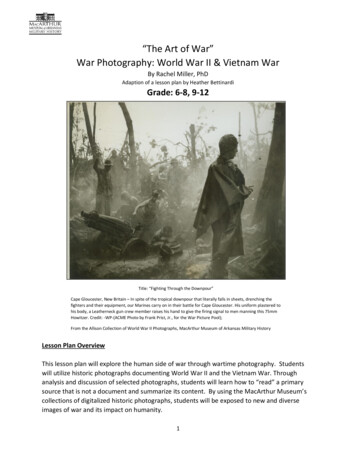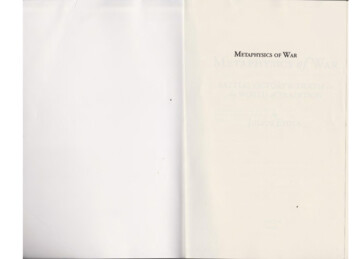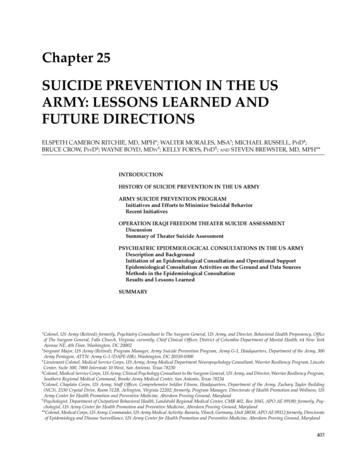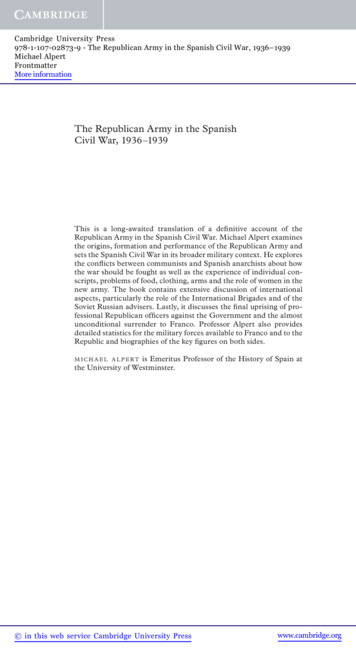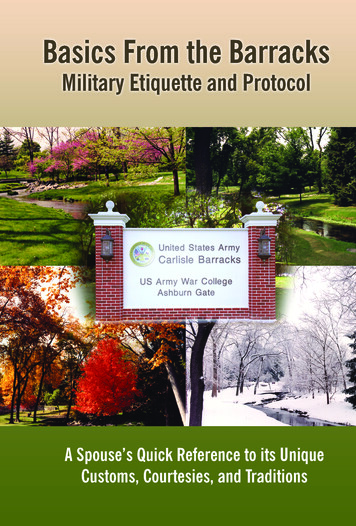
Transcription
ies,andTraditions
BASICS FROM THE BARRACKS— MILITARY ETIQUETTE AND PROTOCOLA SPOUSE’S QUICK REFERENCE TO ITSUNIQUE CUSTOMS, COURTESIES, AND TRADITIONS1
FOREWORD2
INTRODUCTIONEach year at the United States Army War College (USAWC), the spousesof the students are given the opportunity to participate in a classproject. For the past years, spouse committees have chosen to writehandbooks regarding information pertinent to spouses and familymembers in the Armed Forces.It has been our privilege to continue the tradition of the spouse projectby creating a guide to military protocol and etiquette. This is theculmination of both fact and reference material as well as experienceand knowledge of a committee of senior military spouses. Althoughthe committee attempted to broaden our scope to generally apply tothe military as opposed to a particular branch and touch on pertinenttopics to this technological generation, it cannot be denied that an Army“old school” traditional slant is evident. Throughout this guide, thereare boxed references to provide a historical context for many of thesesubjects in order to further appreciate our unique military traditions andcustoms.There are many wonderful definitive resources upon which spouses canrely. In fact, instead of reinventing, we started with a chapter from theCompany Commander’s Battle Book updated in 2010, with a distinctlydifferent mission. So, you will see many verbatim references withenhancements and additions to support the purpose of this document isto provide a quick reference guide to many of the common areas whichaffect military spouses. Interest in the detailed aspects should check ourresource guide.These spouses from the AWC 2010-2011 supported this effort:Shelle Altieri, Team LeaderTerry DrushalPatricia HanleyKathy HarlanIntan ZakariaNahid KabirLisa VereenRelisa Wilson3
With the importance of the joint and international environment, we feelit is important to include basic information about international customsand etiquette. Several International Fellows (IF) student spousesgenerously completed questionnaires and provided their personalthoughts and experiences in their own words to help American spouseslearn more about their country’s customs and courtesies. These IFstudent spouses supported this effort:Sabah Smahi, AlgeriaAneliya Hristora, BulgariaRhonda Macaulay, CanadaMonica Hernandez, ChileBesy de Campos, El SalvadorIda Farida, IndonesiaSilvia Longo, ItalyIdogawa Tomomi, JapanSoyeon Kim, KoreaIntan Zakaria, MalaysiaLoubna Serghini Idrissi, MoroccoAnnette Rietdijk, NetherlandUmran Gor, TurkeyAdditionally, Jack Poe of Air Force Institute of Technology (AFIT) andLisa Lawrence provided useful information and guidance as to the mostcurrent protocol guidelines. Finally, we wish to thank the support of thecommand team spouses, the staff of the Military Family Program, andthe director of the International Fellows Spouse Program as well as thesolid base provided by the AWC 09-10 Spouses Project Team.Finally, we wish to thank the support of the command team spouses,the AWC Military Family Program and the graphics and publishing staff,the director of the Interanational Fellows Spouse Program as well as thesolid base provided by the AWC 09-10 Spouses Project Team.Nothing is less important than which fork you use. Etiquette is thescience of living. It embraces everything. It is ethics. It is honor.Emily Post4
TABLE OF CONTENTSETIQUETTE VERSUS PROTOCOL . 8ETIQUETTE . 8MILITARY ETIQUETTE . 8PROTOCOL . 8BASIC TRAINING . 9RANK . 9PRECEDENCE .11FORMS OF ADDRESS.11ROSTERS .12INTRODUCTIONS AND NAMETAGS .13CORSAGES .13OTHER COURTESIES .14PLEDGE OF ALLEGIANCE, NATIONAL ANTHEM,AND THE ARMY SONG .14BUGLE CALLS .16FLAG ETIQUETTE .17HOW TO DISPLAY THE AMERICAN FLAG .18WHEN TO DISPLAY THE FLAG .22SERVICE BANNERS .24MEDAL OF HONOR RECIPIENTS.26INVITATIONS .27SENDING AN INVITATION.27FORMAT FOR AN INVITATION .27OTHER IMPORTANT INFORMATION .27AN EXAMPLE OF AN INVITATION .28CONSIDERATION FOR CHILDREN .29UNANSWERED R.S.V.P.’S .29ANNOUNCEMENTS .29ELECTRONIC INVITATIONS.29RECEIVING INVITATIONS .30RESPONDING TO AN INVITATION .31COMMUNICATION AND CORRESPONDENCE .31THANK YOU NOTES .32CALLING CARDS .325
ATTENDING EVENTS.35ATTIRE.35COMING AND GOING .37RECEIVING LINES .37TOASTING .39BLESSINGS .39GIFT GIVING .39RECIPROCITY .40MILITARY FUNCTIONS/CEREMONIES.41PARADES and REVIEWS .41PROMOTION AND AWARD CEREMONIES .41CHANGE OF COMMAND ORRESPONSIBILITY CEREMONIES .42RETIREMENT CEREMONIES .43MEMORIALS .43SOCIAL EVENTS.45COFFEE .45DINING IN .46DINING OUT .46FORMAL BALLS .47PROMOTION PARTY .47NEW YEAR’S DAY/HOLIDAY RECEPTION.47THANKSGIVING DINNER AT THE DINING FACILITY .48CHANGE OF COMMAND RECEPTIONS .49SPOUSE WELCOMES AND FAREWELLS .49TEAS.50UNIT HAIL & FAREWELLS (UNIT PARTIES) .52ENTERTAINING .53PARTY PLANNING CHECKLIST .53TABLE SEATING .55TABLE SETTING .56HOSTING A COFFEE .59TECH ETIQUETTE .60CELL PHONE .60EMAIL .61SOCIAL MEDIA.616
PERSPECTIVES ON INTERNATIONAL ETIQUETTE . 64ALGERIA . 64BULGARIA . 68CANADA . 69CHILE. 70EL SALVADOR . 72INDONESIA. 73ITALY . 75JAPAN . 76KOREA . 77MALAYSIA . 78MOROCCO . 80NETHERLAND . 81TURKEY . 82RESOURCES . 847
ETIQUETTE VERSUS PROTOCOLBasic good manners and common courtesies serve you well in allaspects of life. They make people feel at ease with you, with themselves,and with the situation, and allow everyone to have a basic idea of whatto expect.As military spouses, we attend a variety of social and unique militaryevents. Primarily for us it is a combination of military traditions,etiquette and common sense. This guidance creates a system ofaccepted social patterns so that we know what to expect in a givensituation. Knowing these general guidelines can help you feel morecomfortable in the many social and military related situations, whichyou may choose to attend. And, if you are a senior spouse, otherspouses may look to you for cues and examples of how to handle certainsituations .do I sit or stand, etc.ETIQUETTEEtiquette is defined as ―the forms required by good breeding, socialconventions, or prescribed by authority, to be observed in social orofficial settings; the rules of decorum .of graciousness. Etiquettemeans good manners in our daily life. In our cases, it means knowingthe appropriate attire to wear to various events, how to send invitations,and what to bring for your host and/or hostess. More importantly,good etiquette is simply to treat people the way you would want to betreated. It involves the amount of respect you give someone, no mattertheir rank or standing in life.MILITARY ETIQUETTEMilitary Etiquette is the everyday good manners along with the customs,courtesies, and traditions of the different services.PROTOCOLProtocol is the strict form of etiquette and diplomatic courtesy, customsof service (system of accepted social patterns and traditions accepted bythe military) and common courtesies (the traits of kindness, friendliness,thoughtfulness and consideration of others) to create order. They let usknow what to expect in a given situation.8
BASIC TRAININGRANK9
10
PRECEDENCEPrecedence is basically a priority in order. For the military, this isprimarily shown in rank; however, it can be very important to seatingarrangements, receiving lines, introductions, and so on. Officialprecedence will likely be handled by your unit Adjutant or ProtocolOffice.FORMS OF ADDRESSForms of Address will vary depending upon the situation andpurpose (i.e., official or social invitation, place card, introduction,or conversation.) Invitations are discussed below. For detailedinformation, two excellent resources are: Protocol by McCaffree andInnis and Honor and Respect by Hickey.For InvitationsThe military member being invited in an official capacity is listed first:Major Mary Jane Doe and Colonel John DoeorMajor Mary Jane Doeand Colonel John DoeBoth military members invited in an official capacity - higher rank first:Captain John Doe and Lieutenant Jane DoeorCaptain John Doeand Lieutenant Jane DoeFemale military member and civilian husband:Major Mary Jane Doe and Mr. John DoeorMajor Mary Jane Doeand Mr. John DoeIf wife is civilian and retained her maiden name:Captain John Doe and Ms. Jane SmithorCaptain John Doeand Ms. Jane Smith11
Military members are both of the same rank:The Captains John and Jane DoeorCaptain Jane Doeand Captain John DoeTwo different last names:Captain John Doe and Jane DeerorCaptain John Doeand Jane DeerRetired:Colonel Robert W. Thompson, USA, RetiredDivorced from husband: Mrs. Jane DoeWidow: Mrs. John DoeROSTERSThere are numerous rosters within a unit. Each serves the samepurpose: to contact people and pass information. However, each rosterwill have different information and different people depending on thetype of roster. The most common kinds of rosters that a spouse may befamiliar with are: the Social Roster, the FRG Chain of Concern, the UnitCoffee Roster. The Social Roster lists phone numbers and addresses of allsenior personnel (usually officer and NCO specific) within theunit. Inclusion on the roster and to particular events is at thediscretion of the command team and, sometimes, their spouses.This roster is created by the Adjutant and usually provides theSoldier‘s name; the spouse‘s name; birth month/birth day;address; phone numbers; and arrival date to the unit. The Family Readiness Group (FRG) Chain of Concern lists thephone numbers, emails, and addresses of all the memberswithin the unit‘s FRG. This list is used for official contact anddissemination of information. The FRG Chain of Concern is madefrom this master list.12
The Coffee Roster lists all the members of the Coffee groupand includes phone numbers, addresses, emails, birthdays, andanniversaries. Only the members of the coffee group receive thisroster.INTRODUCTIONS AND NAMETAGSThe three basic rules to introductions are: Woman’s name first: Men are introduced to women by statingthe woman‘s name first. Older person’s name first: When two people are of the samesex, the younger adult is introduced to the older adult by statingthe older person‘s name first. Senior officer’s name first: Junior officers are introduced tosenior officers by stating the senior officer‘s name first; thesame for senior officer‘s spouse.If you are nervous about introducing someone, if you forgot names,politely ask for the person(s) to repeat their name. This is certainly nota reason to avoid conversation. For more information , please see theForms of Address section.You should always address senior officers and their spouses as ―LTCSmith or ―Mr./Mrs. Smith until they ask you to do otherwise. If he/shedesires that you call him/her by his/her first name, he/she will tell you.Do not take the liberty until then. If you are asked to use a first name, itis polite to do so.Nametags are used for many occasions and are worn on the right side(the side with which you shake hands. This makes it easy for the personshaking hands to subtly look at your name.)CORSAGESIt generally does not matter the side on which the lapel corsage is worn;however, the “flowers go the way they grow” with the stems on thebottom and the flowers on the top.13
OTHER COURTESIESNormally smoking and chewing gum are inappropriate at military orsocial events.When entering a Military Installation: When entering or leaving an installation with a guarded gate atnight, dim your headlights 50 feet before the gate so you willnot temporarily blind the gate guard. If you or a guest does not have a DOD ID Card, you will be askedto provide a picture ID. If your car does not have a DOD sticker and the driver doesnot have a DOD ID Card, you will be asked to go to the searcharea where you will need to provide your driver’s license,car registration, and proof of insurance. You will be askedto get out of the vehicle, open all doors, trunks, and enginecompartments, and step to the side while your car is searched. Even with a DOD sticker, you are still subject to randomsearches. Although speed limits vary on posts of different sizes, it isimportant to note that the speed limit in residential areas is 15mph.PLEDGE OF ALLEGIANCE, NATIONAL ANTHEM, AND THE ARMY SONG It is customary to stand for the Pledge of Allegiance andNational Anthem. Outside, place your hand on your heart. Inside, you can eitherplace your hand over your heart, have your hands at yoursides, or behind your back. Civilian gentlemen should removeheadgear in both cases. Outside rules apply if the ceremonyis moved indoors because of weather or security. This may benoted in the program or by the announcer. One should not smoke, eat, chew gum, drink, use your cellphone, read or otherwise occupy themselves while the Anthemis playing. Generally speaking, the National Anthem should be performedin the traditional manner in order to allow other U.S. Citizensto sing along should they so desire. Although not required,depending upon the solemnity of the occasion, it is appropriateto sing along.14
It is appropriate to stand for the anthems of other countriesrepresented as a sign of respect. Stand for: Ruffles & Flourishes (when General is present, theband plays it once for each star he/she has); To the Colors(National Anthem), and Colors Pass in Review. Don‘t forget that you will need to stand when the colors are sixpaces to your right, in front of you and for the six paces to yourleft, then you may sit as the colors pass in review. Stand when the unit plays the Division, and/or Army song. Youcan usually find the words to both in the event program. It isencouraged to learn and sign proudly your unit song. The first verse and the refrain of The Army Song are listed below.THE ARMY SONG, 1956First Chorus:First to fight for the right,And to build the Nation‘s might,And the Army Goes Rolling Along.Proud of all we have done,Fighting till the battle‘s won,And the Army Goes Rolling Along.Refrain:Then it‘s hi! Hi! Hey!The Army‘s on it way.Count off the cadence loud and strong;For where‘er we go,You will always knowThat the Army Goes Rolling Along.You will often hear the playing of “The ArmySong”, a tradition added fairly recently. It isderived from the Field Artillery song “The CaissonsGo Rolling Along” written during World War I bytwo Field Artillery soldiers.15
BUGLE CALLSBugle calls are musical signals that announce scheduled and certainnon-scheduled events on some military installations. Although the exacttime might vary, typically, they include:Monday thru Friday6:00am or 6:30am is ―Reveille. This call marks the raising of theflag and the beginning of the workday.8:00am is ―Work Call. This call marks the start of the work day.1:00pm is ―Work Call. This call marks the return to work afterlunch.4:30 pm is ―Recall.5:00 pm is ―Retreat and To the Colors. This call signifies thelowering of the flag and the official end of the workday.Often a canon will sound in between these two calls.9:00 pm is ―Tattoo. This call means quiet or lights out.11:00pm is ―Taps. This call means lights out.Saturday12:00pm is ―Mess Call5:00pm is ―Retreat and To the Colors9:00 pm is ―Tattoo11:00pm is ―TapsSunday9:00am is ―Church Call5:00 pm is ―Retreat and To the Colors11:00pm is ―Taps During Retreat, if you are outside, stand quietly at attentionfacing the flag or music. During Reveille and To the Colors, placeyour hand over heart or salute if in uniform. Children shouldalso stop playing and observe the custom of the ceremony. During Reveille and Retreat, the rules vary depending upon theinstallation, but if you are in a car and will not impede the flowof traffic, you should stop, get out, and stand as above. If thereare children in the car, use your judgment based upon theirages. On Navy and Air Force bases you are only required to stop thecar and remain seated.16
Additionally, the times of certain bugle calls may vary basedupon the installation. Check with your unit protocol office formore information. It is customary and respectful to stand for Foreign CountryAnthems but do not salute Foreign Flags.The bugle called retreat was first used bythe French army and is said to go back to thetime of the Crusades. “Retraite”(we now callthat”retreat”) signified the closing in of night andsignaled the sentries to start challenging to maintain their security watch until reveille the nextmorning.FLAG ETIQUETTEFederal law stipulates many aspects of flag etiquette. The section oflaw dealing with American Flag etiquette is generally referred to as theFlag Code. A great resource on Flag Etiquette is Independence HallAssociation at www.ushistory.org . Some general guidelines from theFlag Code answer many of the most common questions: The US flag should never touch the ground. Fold it properly andstore it properly.The flag should be lighted at all times, either by sunlight or by anappropriate light source. Otherwise, it should be taken downprior to sunset.The flag should be flown in fair weather, unless the flag isdesigned for inclement weather use.The flag should never be dipped to any person or thing. It isflown upside down only as a distress signal.The flag should not be used for any decoration in general.Bunting of blue, white and red stripes is available for thesepurposes. The blue stripe of the bunting should be on the top.The flag should never be used for any advertising purpose. Itshould not be embroidered, printed or otherwise impressedon such articles as cushions, handkerchiefs, napkins, boxes,or anything intended to be discarded after temporary use.Advertising signs should not be attached to the staff or halyard.17
Wearing the American flag is disrespectful as a cloth print. Thewearing of an actual American Flag is considered improper inall circumstances. This includes draping it over oneself. The flagshould not be used as part of a costume or athletic uniform,except that a flag patch may be used on the uniform of militarypersonnel, fireman, policeman and members of patrioticorganizations. The flag should never have any mark, insignia, letter, word,number, figure, or drawing of any kind placed on it, or attachedto it. The flag should never be used for receiving, holding, carrying, ordelivering anything. When the flag is lowered, no part of it should touch the groundor any other object; it should be received by waiting handsand arms. To store the flag it should be folded neatly andceremoniously. The flag should be cleaned and mended when necessary. When a flag is so worn it is no longer fit to serve as a symbolof our country, it should be destroyed by burning in a dignifiedmanner. It is more respectful to take down a torn flag thanit is to keep flying. The proper disposal of the American flagis to burn it! The American Legion, Veterans of Foreign Wars,Disabled American Veterans Organizations, and a local Boy orGirl Scout Troop will facilitate this should a citizen so choose.The flag should not be thrown in the garbage.HOW TO DISPLAY THE AMERICAN FLAGRules compiled by the Independence Hall Association (http://www.ushistory.org/betsy/flagetiq.html) are:1. When the flag is displayed over the middle of thestreet, it should be suspended vertically with the unionto the north in an east and west street or to the east ina north and south street.18
2. The flag of the United States of America, when it isdisplayed with another flag against a wall from crossedstaffs, should be on the right, the flag’s own right [thatmeans the viewer’s left --Webmaster], and its staffshould be in front of the staff of the other flag.3. The flag, when flown at half-staff, should be firsthoisted to the peak for an instant and then loweredto the half-staff position. The flag should be againraised to the peak before it is lowered for the day. By“half-staff ” is meant lowering the flag to one-half thedistance between the top and bottom of the staff.Crepe streamers may be affixed to spear heads or flagstaffs in a paradeonly by order of the President of the United States.4. When flags of States, cities, or localities, or pennantsof societies are flown on the same halyard with the flagof the United States, the latter should always be at thepeak. When the flags are flown from adjacent staffs,the flag of the United States should be hoisted first andlowered last. No such flag or pennant may be placed above the flag ofthe United States or to the right of the flag of the United States (theviewer’s left). When the flag is half-masted, both flags are half-masted,with the US flag at the mid-point and the other flag below.5. When the flag is suspended over a sidewalk froma rope extending from a house to a pole at the edgeof the sidewalk, the flag should be hoisted out, unionfirst, from the building.19
6. When the flag of the United States is displayed froma staff projecting horizontally or at an angle from thewindow sill, balcony, or front of a building, the union ofthe flag should be placed at the peak of the staff unlessthe flag is at half-staff.7. When the flag is used to cover a casket, it should beso placed that the union is at the head and over the leftshoulder. The flag should not be lowered into the graveor allowed to touch the ground.8. When the flag is displayed in a manner otherthan by being flown from a staff, it should bedisplayed flat, whether indoors or out. Whendisplayed either horizontally or vertically againsta wall, the union should be uppermost and tothe flag’s own right, that is, to the observer’s left. When displayed in awindow it should be displayed in the same way, that is with the unionor blue field to the left of the observer in the street. When festoons,rosettes or drapings are desired, bunting of blue, white and red shouldbe used, but never the flag.9. That the flag, when carried in aprocession with another flag, or flags, should be either on the marchingright; that is, the flag’s own right, or, if there is a line of other flags, infront of the center of that line.10. The flag of the United States of America should be atthe center and at the highest point of the group when anumber of flags of States or localities or pennants ofsocieties are grouped and displayed from staffs.20
11. When flags of two or more nations are displayed,they are to be flown from separate staffs of the sameheight. The flags should be of approximately equalsize. International usage forbids the display of theflag of one nation above that of another nation intime of peace. The order of precedence for flags generally is Nationalflags (US first, then others in alphabetical order in English), State (hoststate first, then others in the order of admission) and territories(Washington DC, Puerto Rico, etc.), Military (Army, Marine Corps, Navy,Air Force, Coast Guard), then other.12. When displayed from a staff in a church orpublic auditorium on or off a podium, the flag of the United States ofAmerica should hold the position of superior prominence, in advance ofthe audience, and in the position of honor at the clergyman’s orspeaker’s right as he faces the audience. Any other flag so displayedshould be placed on the left of the clergyman or speaker (to the right ofthe audience). Please note that the old guidelines differed from thisupdated and simplified one.13. When the flag is displayed on a car, the staffshall be fixed firmly to the chassis or clamped to the right fender.14. When hung in a window, place the blue union inthe upper left, as viewed from the street21
WHEN TO DISPLAY THE FLAGSection 6d of the Flag Code states:The flag should be displayed on all days, especially on: New Year’s Day, Jan. 1 Inauguration Day, Jan. 20 Martin Luther King Jr.’s birthday, 3rd Monday in Jan. Lincoln’s Birthday, Feb. 12 Washington’s Birthday, 3rd Monday in Feb. Easter Sunday (variable) Mother’s Day, 2nd Sunday in May Armed Forces Day, 3rd Saturday in May Memorial Day, last Monday in May, (half-staff until noon) Flag Day, June 14 Father’s Day, 3rd Sunday in June Independence Day, July 4 National Korean War Veterans Armistice Day, July 27 Labor Day, 1st Monday in Sept. Constitution Day, Sept. 17 Columbus Day, 2nd Monday in Oct. Navy Day, Oct. 27 Veterans Day, Nov. 11 Thanksgiving Day, 4th Thursday in Nov. Christmas Day, Dec. 25 and such other days as may be proclaimed by the President ofthe United States the birthdays of States (date of admission) and on State holidays22
Half-Staff the Flag on these Days: May 15 — Peace Officers Memorial Day: half-staff from sunriseto sunset Last Monday in May — Memorial Day: the flag should bedisplayed at half-staff until noon September 11 — Patriot Day: half-staff from sunrise to sunset First Sunday in October — Start of Fire Prevention Week: halfstaff from sunrise to sunset. See Public Law 107-51 December 7 — National Pearl Harbor Remembrance Day: halfstaff from sunrise to sunset Upon reliable information that a past or present President, VicePresident, Chief Justice, or Speaker of the House has died Upon Presidential proclamation or proclamation from yourstate’s governor(This material is copyright by, and used with permission of, theIndependence Hall Association, on the web at ushistory.org.)The “Colors” (US flag and regimental flag) arecarried by color bearers (NCOs today). The colorGuards “protect” the flags. Traditionally, whensoldier
As military spouses, we att end a variety of social and unique military events. Primarily for us it is a combinati on of military traditi ons, eti quett e and common sense. This guidance creates a system of accepted social patt erns so that we know what to expect in a given situati on. Knowing these general guidelines can help you feel more



